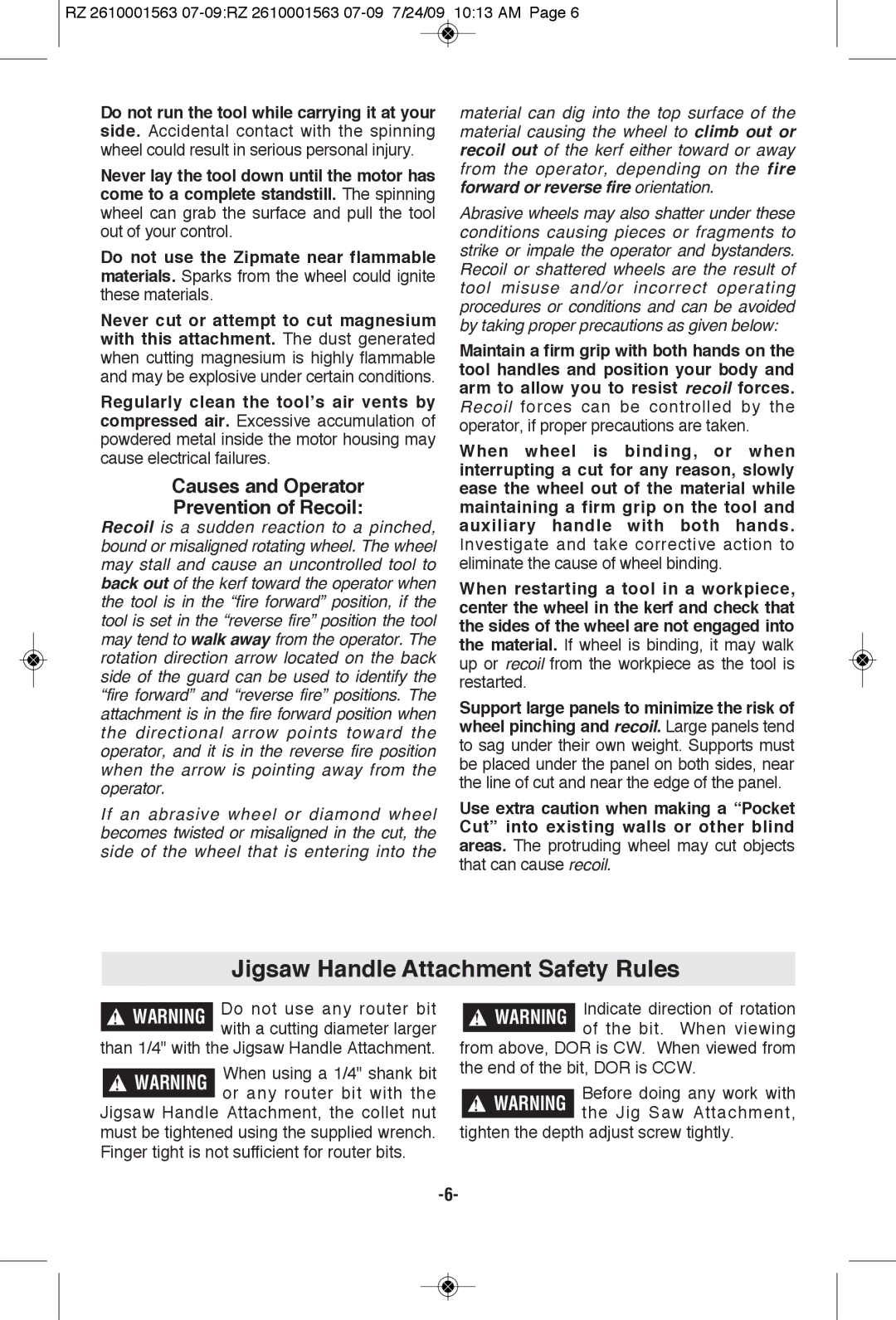
RZ 2610001563 07-09:RZ 2610001563 07-09 7/24/09 10:13 AM Page 6
Do not run the tool while carrying it at your side. Accidental contact with the spinning wheel could result in serious personal injury.
Never lay the tool down until the motor has come to a complete standstill. The spinning wheel can grab the surface and pull the tool out of your control.
Do not use the Zipmate near flammable materials. Sparks from the wheel could ignite these materials.
Never cut or attempt to cut magnesium with this attachment. The dust generated when cutting magnesium is highly flammable and may be explosive under certain conditions.
Regularly clean the tool’s air vents by compressed air. Excessive accumulation of powdered metal inside the motor housing may cause electrical failures.
Causes and Operator
Prevention of Recoil:
Recoil is a sudden reaction to a pinched, bound or misaligned rotating wheel. The wheel may stall and cause an uncontrolled tool to back out of the kerf toward the operator when the tool is in the “fire forward” position, if the tool is set in the “reverse fire” position the tool may tend to walk away from the operator. The rotation direction arrow located on the back side of the guard can be used to identify the “fire forward” and “reverse fire” positions. The attachment is in the fire forward position when the directional arrow points toward the operator, and it is in the reverse fire position when the arrow is pointing away from the operator.
If an abrasive wheel or diamond wheel becomes twisted or misaligned in the cut, the side of the wheel that is entering into the
material can dig into the top surface of the material causing the wheel to climb out or recoil out of the kerf either toward or away from the operator, depending on the fire forward or reverse fire orientation.
Abrasive wheels may also shatter under these conditions causing pieces or fragments to strike or impale the operator and bystanders. Recoil or shattered wheels are the result of tool misuse and/or incorrect operating procedures or conditions and can be avoided by taking proper precautions as given below:
Maintain a firm grip with both hands on the tool handles and position your body and arm to allow you to resist recoil forces. Recoil forces can be controlled by the operator, if proper precautions are taken.
When wheel is binding, or when interrupting a cut for any reason, slowly ease the wheel out of the material while maintaining a firm grip on the tool and auxiliary handle with both hands. Investigate and take corrective action to eliminate the cause of wheel binding.
When restarting a tool in a workpiece, center the wheel in the kerf and check that the sides of the wheel are not engaged into the material. If wheel is binding, it may walk up or recoil from the workpiece as the tool is restarted.
Support large panels to minimize the risk of wheel pinching and recoil. Large panels tend to sag under their own weight. Supports must be placed under the panel on both sides, near the line of cut and near the edge of the panel.
Use extra caution when making a “Pocket Cut” into existing walls or other blind areas. The protruding wheel may cut objects that can cause recoil.
Jigsaw Handle Attachment Safety Rules
!WARNING Do not use any router bit with a cutting diameter larger
than 1/4" with the Jigsaw Handle Attachment.
!WARNING When using a 1/4" shank bit or any router bit with the
Jigsaw Handle Attachment, the collet nut must be tightened using the supplied wrench. Finger tight is not sufficient for router bits.
!WARNING Indicate direction of rotation of the bit. When viewing
from above, DOR is CW. When viewed from the end of the bit, DOR is CCW.
Before doing any work with the Jig Saw Attachment,
tighten the depth adjust screw tightly.
